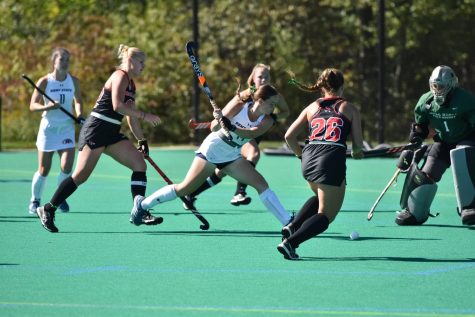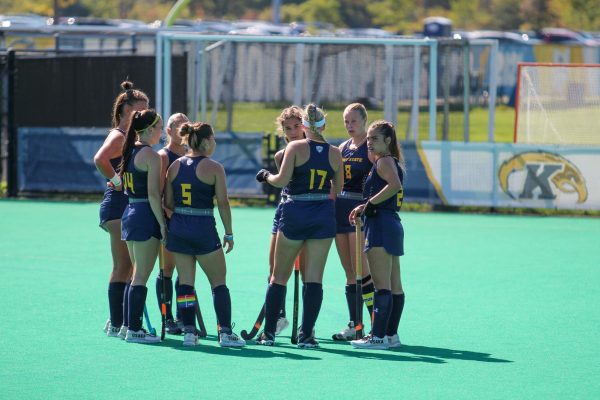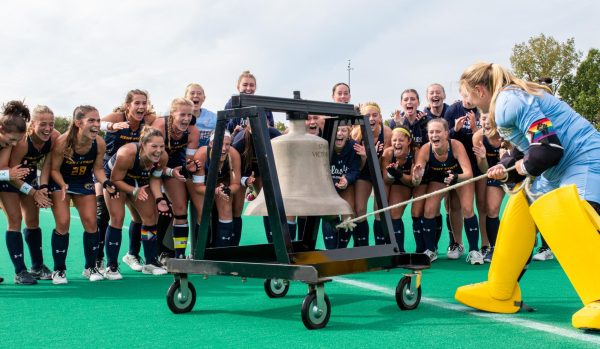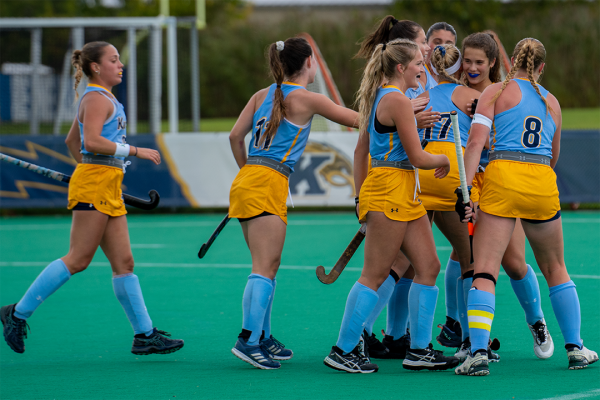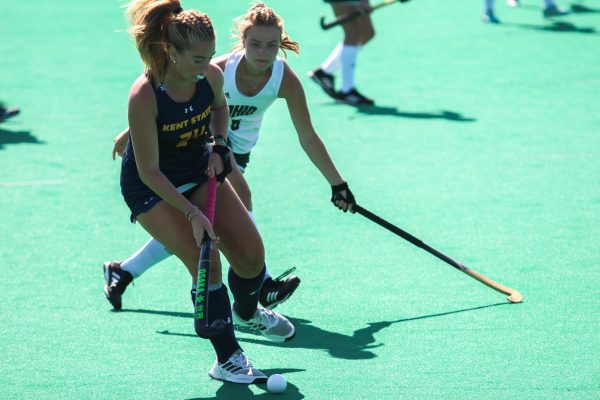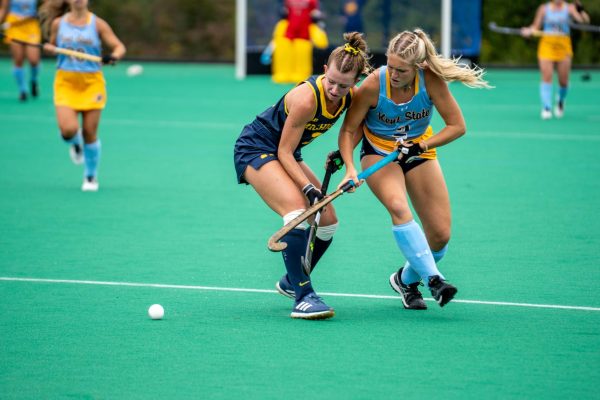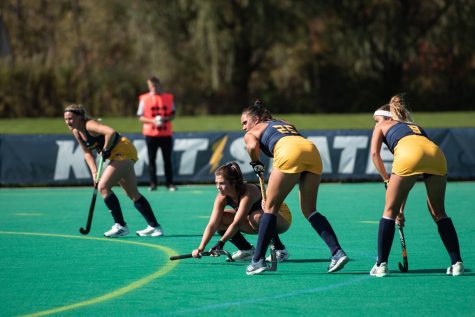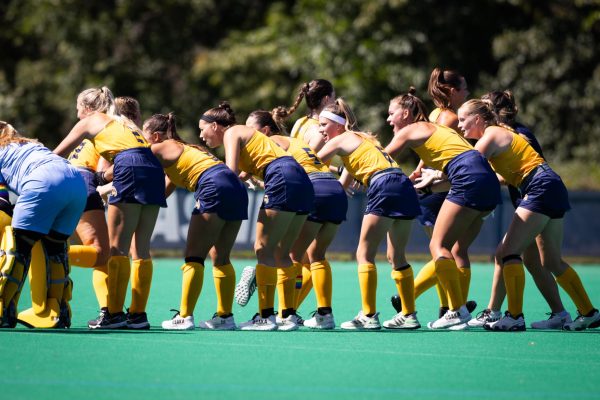Field hockey for dummies
September 29, 2008
Andy McEntee | Daily Kent Stater
Credit: DKS Editors
While field hockey is one of the most fast-paced, energetic collegiate sports, it is also one of the least understood. To break down the game is no easy task, but understanding the sport is possible. Here’s a beginner’s guide to the game of field hockey:
Positions
Eleven players from each team play at one time. Of those 11, there are three different positions: back, midfielder and forward.
Kent State applies a more traditional style, playing with a 4-3-3 setup. Four backs, three midfielders and three forwards play at once.
Backs
Backs have a defensive mindset. Their role is to halt play in the defensive zone and progress the ball on to the midfielders and forwards. For Kent State, freshman Carla Johl, redshirt freshman Stephanie Arbelaez, sophomore Kara Rhodenbaugh and senior Stephanie Bernthal have been getting the majority of the starts in the backfield.
Forwards
Yes, this position is normally at the top of the scoring list on most teams, but forwards are special because they have more than offensive responsibilities. The forwards are also the first line of defense on the field. Staying with the play and learning good defense are qualities a forward must display. For the Flashes, starters sophomore Nicole Leach and junior Natalie Barrett are tied with eight points on the season, while third starter junior Laurie Wilkins has five.
Midfielders
Midfielders are what you call two-way players. They have to adopt a defensive and offensive mindset for all facets of the game. The first responsibility is to eliminate the opposing attack. Once this is completed, midfielders must distribute the ball down the field into the offensive zone, where the forwards sit. Sophomore Rachel Miller leads all midfielders with five goals and two assists for a total of 12 points. Junior Allison Kittelberger (seven points) and sophomore Katie George (one point) round out the starting midfield.
The ball
A field hockey ball is slightly bigger than a baseball, and it has dimples on it like a golf ball.
Goalkeeper
The goalkeeper is the 11th player on the field. Much like goalkeepers in other sports, field hockey goalkeepers don’t stray far from the goal area. Goalies do come out to challenge breakaways and corner opportunities to cut off the shooter’s angle. Also, this is the only position where a player may advance the ball with something other than a stick, as goalkeepers can throw or kick the ball as well. Sophomore Caroline Suitch has played every minute of every game thus far this season for Kent State. She has a 1.65 goals-against average and .761 save percentage.
Gameplay and goals
Players on each side must play the ball into the striking circle, which is the only place shots on goal can come from.
If a shot taken from outside the circle goes in, it doesn’t count. However, if a shot from outside the circle gets tipped by an offensive player in the striking circle and goes in, the goal does count.
Possession
A team loses possession when it commits a foul with the ball or hitting the ball out of bounds. Also, when the attacking team plays the ball over the goal line, the defending team gets a free hit 16 yards from the spot the ball crossed.
Equipment
Shots are aimed at a 7-foot high, 12-foot wide goal. To shoot, players have a specially designed stick, which has a curved head. Half of the shaft is round, and the ball must only be touched with the flat side of the stick.
Players wear shin pads to protect their legs from the impact of the ball and opposing sticks. Backs and some midfielders may also choose to wear padded gloves, much like that of offensive and defensive linemen in football, during play.
Only goalkeepers carry additional pieces of equipment, and their pads resemble that of a goalie in ice hockey. A helmet, chest protector, leg pads, arm pads, hand protectors and stick are all part of a goalie’s ensemble.
Game Length
Collegiate play has two 35-minute halves. If the game is tied after the second half, there are two 10-minute overtime periods. Each period is sudden death, with the first team to score getting the win. If the game is still tied after the second overtime period, five players from each team alternate taking penalty strokes.
The field
Field hockey fields are normally artificial turf. In the Mid-American Conference, only one school, Missouri State, has a grass field. The fields are watered down before the games and at half-time to slow the ball down during play. The field is 100 yards long and divided into 25-yard segments by the midfield and 25-yard lines.
Fouls
Fouls are periodically called by either of the two umpires. Fouls are called for any number of reasons, but most center around the players’ use of their sticks.
Players must allow each other an equal chance to gain control of the ball. Thus, any obstruction with the body or stick is not allowed and will be called.
Playing the ball with the rounded side of the stick is a foul, and interfering without a stick will be called. Charging, hitting, shoving and tripping are offenses that draw a foul as well.
Umpires focus on the concern of player safety. Therefore, any dangerous or intimidating action with the stick is not tolerated.
After a foul is called, the team that committed the infraction must allow five yards of space for a free hit to the other team. Much like soccer, when a foul is called, play halts only momentarily to reset and start again.
Penalty Corners
Depending on where a foul is committed, a penalty corner may be awarded. Any foul by the defending team inside the circle becomes a penalty corner for the attacking team.
On a penalty corner, all attackers must be outside the shooting circle, and a maximum of five defenders can start behind the goal line. One attacker sets the ball on the end line, at least 10 yards away from the net, and passes the ball to a teammate, making sure the ball leaves the striking circle at least momentarily.
If the ball goes in on the first shot, it must be no higher than 18 inches. There is a black board on the bottom of every goal denoting this space. Any other type of shot (deflection, push or scoop) may cross the goal line at any height and count as a goal.
Contact sports reporter Chris Gates at [email protected].













